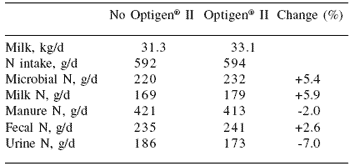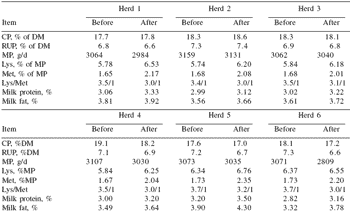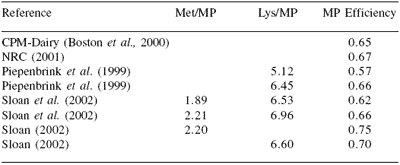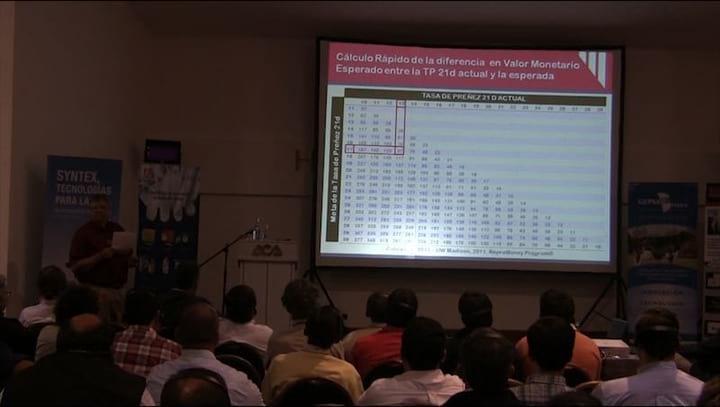feeding of nitrogen to lactating dairy cows
Precision feeding of nitrogen to lactating dairy cows: a role for Optigen® II
Over the last three decades, our emphasis in ration formulation has shifted from only milk volume and fat to include milk protein percentage and yield.
In recent years more precise mathematical approaches have now allowed us to improve models of nutrient use tremendously. They will be used more frequently in the future for support of decisions not only on the nutrition of cattle, but for other aspects including farm economics and environmental impact.
Feeding management has been identified as a key to reduce excess nutrient loss on dairy farms (Tamminga, 1992; Tylutki and Fox, 2000).
The animal industries use the term ‘precision feeding’ to describe the formulation of rations to reduce nutrient excretion and feed costs (Cast, 2002; Fox et al., 2002).
Excessive excretion of nitrogen and phosphorus has received the most attention. This report focuses on reducing nitrogen excretion. The reader is directed towards publications by Cerosaletti et al. (2003; 2004) Cerosaletti (2006), Chase (1994) and Tylutki and Fox (2000) for strategies and programs to reduce phosphorus excretion.
Nitrogen utilization
The most frequently used index of nitrogen utilization is the quantity of feed nitrogen captured in milk. Chase (2003) evaluated nitrogen utilization from 334 treatment means from 62 research papers and found that the average percentage of feed nitrogen captured in milk was 27% (range 16.2 to 45.2%). The low capture of feed nitrogen into milk is disturbing, but the variation indicates that there are opportunities to improve this efficiency. Opportunities to increase the capture of feed nitrogen into milk lie in four main areas:
(1) the amount of nitrogen in rations
(2) the efficiency of bacterial growth in the rumen
(3) intestinal digestibility of rumen escape protein
(4) the amino acid balance of absorbed (metabolizable) protein
THE AMOUNT OF NITROGEN IN RATIONS
Broderick (2005) fed rations ranging from 13.5 to 19.4% crude protein (Table 1). Crude protein was increased by replacing high moisture corn with soybean meal. The data show that microbial protein, milk production, milk components and nitrogen efficiency were optimal at 16.5% crude protein. Does this mean that rations for lactating dairy cows should not contain more than 16.5% crude protein? No! It means that we need to look at the entire ration in terms of carbohydrate fermentability, bacterial growth and the amino acid balance of absorbed protein. But, the Broderick (2005) data clearly show that over-feeding crude protein decreases the efficiency of capture of dietary protein into milk protein with a corresponding increase in excretion of urea nitrogen in urine.
Table 1. Microbial protein production, milk production, milk composition, urinary nitrogen excretion and efficiency of dietary N capture in milk1.
1Broderick et al. (2005)
2CP increased by replacing high moisture corn with solvent-extracted soybean meal
a-eP<0.05
EFFICIENCY OF MICROBIAL GROWTH IN THE RUMEN
Efficiency of microbial growth is usually expressed as grams of microbial protein per gram of fermentable carbohydrate (or fermentable dry matter). Logically, if more dietary nitrogen can be captured by ruminal microorganisms, the efficiency with which dietary nitrogen is captured in milk should increase. There are many feed additives that manufacturers claim adjust ruminal fermentation to increase the efficiency of microbial growth. In my review of data, I can only find two feed additives that conclusively show improvements in rumen microbial growth. These are Fermenten®/Biochlor® (Lean et al., 2005) and Optigen® II (Alltech, 2006).
In continuous culture fermentors, Optigen® II increased microbial growth by 5%. In a field study, Tikofsky and Harrison (2006) found that Optigen® II increased milk yield by 1.8 kg/cow. CPM-Dairy (Chalupa and Sniffen, 2006) was used to simulate the impact of an improved microbial growth on nitrogen excretion (Table 2). With Optigen® II, capture of dietary nitrogen in ruminal microbes increased by 5%. This led to 6% more nitrogen in milk with a 7% decrease in urine nitrogen.
Urine nitrogen is in the form of urea. It is rapidly hydrolyzed to ammonia by urease in feces. Ninety percent of ammonia emissions are from agriculture with 90% of the agricultural emissions from livestock (Meisinger and Jokela, 2000). Capturing more dietary nitrogen in ruminal microbes can decrease excretion of urinary urea and reduce ammonia emissions.
Table 2. Simulation1 of the impact of Optigen® II to increase rumen microbial growth and reduce urea nitrogen excretion. 
1Simulation with CPM-Dairy Version 3 (Chalupa and Sniffen, 2006)
INTESTINAL DIGESTIBILITY AND AMINO ACID BALANCE
Noftsger and St-Pierre (2003) examined the impact of dietary crude protein, intestinal digestibility of the rumen undegraded protein (RUP) and amino acid balance on production and nitrogen utilization (Table 3). By using a highly digestible source of rumen undegraded protein (blood, poultry and feather meals), in conjunction with methionine (Rhodimet® AT-88 and Smartamine™), dietary crude protein could be reduced while maintaining milk yield and substantially improving the environmental efficiency of nitrogen usage.
Table 3. Impact of dietary crude protein, intestinal digestibility of RUP and methionine supplementation on production and nitrogen utilization1. 
1Noftsger and St-Pierre (2003)
2Porcine meat meal as the source of RUP (55% digestible)
3Blood, poultry and feather meals as the source of RUP (>89% digestible)
4Rhodimet® AT-88 and Smartamine™
5Calculated using CPM-Dairy version 1 (Boston et al., 2000)
6Milk N/N intake × 100
7kg N excreted/kg N in milk
abcP<0.05
Schwab et al. (2003) examined the impact of increasing concentrations of methionine and lysine in metabolizable protein (MP) in six commercial dairies (Table 4). Lysine was increased by adding blood meal and reducing or eliminating distillers grains or a protected soy product. Methionine concentrations in metabolizable protein were increased with Smartamine™.
These ration changes resulted in a lysine:methionine ratio of 3:1. Methionine in metabolizable protein ranged from 2.01 to 2.35%. Lysine in metabolizable protein ranged from 6.18 to 6.76%. There was no attempt to measure changes in milk yield but in most cases, producers thought they observed higher milk yields. All herds responded with increases in concentrations of protein and fat in milk without a change in metabolizable protein.
Table 4. Responses in commercial dairies of milk protein and fat to increased concentrations of methionine and lysine in metabolizable protein1.
To enlarge the image, click here
1Schwab et al. (2003)
Rats and chickens grow more efficiently when fed diets that contain high quality proteins like casein or egg protein versus diets with poor quality protein like zein. Dairy cattle should respond in a similar manner to metabolizable protein sources that have good amino acid balances.
Efficiencies of milk protein synthesis from metabolizable protein are shown in Table 5. The CPM-Dairy efficiency is 0.65 (Boston et al., 2000). The NRC (2001) efficiency is 0.67. Calculations by Piepenbrink et al. (1999) and Sloan et al. (2002) showed that increasing the concentrations of methionine and lysine in metabolizable protein increases the efficiency of milk protein synthesis.
Summary
Increasing pressure to reduce nitrogen excretion of dairy herds requires feeding rations that maximize conversion of feed nitrogen to milk nitrogen. There are several routes that can be followed. Matching dietary protein to animal requirements is obvious but this means feeding different rations to groups of cattle at different levels of production.
Mainly because of simplicity, many dairymen are not willing to follow this strategy and choose to feed one ration to all production groups. Another alternative is to maximize the ruminal production of microbial protein. The experiment by Noftsger and St-Pierre (2003) showed a 35% improvement in nitrogen efficiency when a ration contained a highly digestible source of rumen degraded protein and was balanced for methionine and lysine in metabolizable protein. The value of balancing methionine and lysine in metabolizable protein to increase milk protein was also demonstrated in a large field study by Schwab et al. (2003). With an improved amino balance, metabolizable protein is used more efficiently for the synthesis of milk protein.
Table 5. Impact of concentration of methionine and lysine in metabolizable protein on the utilization of metabolizable protein for synthesis of milk protein.
References
Alltech. 2006. Influence of Optigen® II on fermentation and microbial growth in continuous culture fermentors. Unpublished data. Alltech Inc., Nicholasville, KY, USA.
Boston, R., D. Fox, C. Sniffen, E. Janczewski, R. Munson and W. Chalupa. 2000. The conversion of a scientific model describing dairy cow nutrition and production to an industry tool: the CPM-Dairy project. In: Modeling Nutrition of Farm Animals (J.P. McNamara, J. France and D.E. Beever, eds). CAB International, Oxford, pp. 361- 377.
Broderick, G. 2005. Feeding dairy cows to minimize nitrogen excretion. In: Proc. Tri- State Dairy Nutr. Conf., Fort Wayne, IN, USA, pp. 137-152.
Chalupa, W. and C. Sniffen. 2006. Balancing rations on the basis of amino acids: The CPM-Dairy approach. In: Proc. Southwest Nutr. and Management Conf. Phoenix, AZ, USA. Univ. Arizona, Tucson, AZ, USA, pp. 96-102.
Chase, L.E. 1994. Environmental considerations in developing dairy rations. In: Proc. Cornell Nutr. Conf. Feed Manuf., Syracuse, NY, USA. Cornell Univ., Ithaca, NY, USA, pp. 56-62.
Chase, L.E. 2003. Nitrogen utilization in dairy cows- what are the limits of efficiency? In: Proc. Cornell Nutr. Conf. Feed Manuf., Syracuse, NY, USA. Cornell Univ., Ithaca, NY, USA. pp. 233-245.
Cerosaletti, P.E. 2006. Application of nutrition models to precision feeding: A user’s perspective. In: Proc. Cornell Nutr. Conf. Feed Manuf., Syracuse, NY, USA. Cornell Univ., Ithaca, NY, USA, pp. 19-26.
Cerosaletti, P.E., D.G. Fox, L.E. Chase and D.C. Frazer. 2003. Precision feed management and its role in watershed protection. In: Proc. Cornell Nutr. Conf. Feed Manuf., Syracuse, NY, USA. Cornell Univ., Ithaca, NY, USA, pp. 251-259.
Cerosaletti, P.E., D.G. Fox and L.E. Chase. 2004. Phosphorus reduction through precision feeding of dairy cattle. J. Dairy Sci. 87:2314-2323.
Council for Agricultural Science and Technology (CAST). 2002. Animal diet modification to decrease the potential for nitrogen and phosphorus pollution. Issue Paper 21, CAST, Ames, IA, USA.
Fox, D.G., T.P. Tylutki, G.L. Albrecht, P.E. Cerosaletti and L.O. Tedeschi. 2002. Environmental protection and the Cornell University Nutrient Management Planning System: future perspectives. In: Proc. Cornell Nutr. Conf. Feed Manuf., Syracuse, NY, USA. Cornell Univ., Ithaca, NY, USA, pp. 79-98.
Lean, I.J., T.K. Miller Webster, W. Hoover, W. Chalupa, C.J. Sniffen, E. Evans, E. Block and A.R. Rabiee. 2005. Effects of BioChlor® and Fermenten® on microbial protein synthesis in continuous culture fermentors. J. Dairy Sci. 88:2524-2536.
Meisinger, J.J. and W.E. Jokela. 2000. Ammonia losses from manure. In: Proc. Cornell Nutr. Conf. Feed Manuf., Syracuse, NY, USA. Cornell Univ., Ithaca, NY, USA, pp. 109-116.
Noftsger, S. and N.R. St-Pierre. 2003. Supplementation of methionine and selection of highly digestible rumen undegradable protein to improve nitrogen efficiency for milk production. J. Dairy Sci. 86:958-969.
National Research Council, 2001. Nutrient Requirements of Dairy Cattle (7th Rev. Ed). National Academy Press, Washington, D.C.
Piepenbrink, M.E., C.G. Schwab, B.K. Sloan and N.L. Whitehouse. 1999. Importance of dietary concentrations of absorbable lysine on maximizing milk protein production of mid lactation cows. J. Dairy Sci. 82(Suppl. 1):93.
Schwab, C.G., R.S. Ordway and N.L. Whitehouse. 2003. Amino acid balancing in the context of MP and RUP requirements. In: Proc. Four-State Dairy Nutr. and Management. Conf., Lacrosse, WI, USA, pp. 25-34.
Sloan, B.K. 2002. http://www.adisseonorthamerica.com/smartamineguide/. Tamminga, S. 1992. Nutrient management of dairy cows as a contribution to nutrient control. J. Dairy Sci. 75:345.
Tikofsky, J. and G.A. Harrison. 2006. Optigen® II. Improving the efficiency of nitrogen in the dairy cow. In: Nutritional Biotechnology in the Feed and Food Industries, Proceedings of Alltech’s 22nd Annual Symposium (T.P. Lyons, K.A. Jacques and J.M. Hower, eds). Nottingham University Press, UK, pp. 65-73.
Tylutki, T.P. and D.G. Fox. 2000. Quality control in herd nutrient management. In: Proc. Cornell Nutr. Conf. Rochester, NY, USA. Cornell Univ., Ithaca, NY, USA, pp. 130-143.
Author: WILLIAM CHALUPA
Global Dairy Consultancy Co. Ltd, Holderness, New Hampshire, USA





